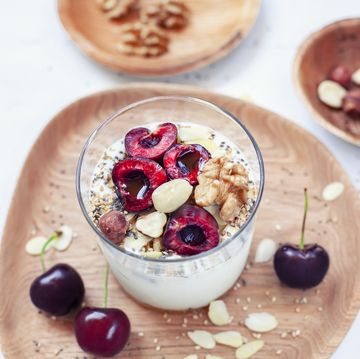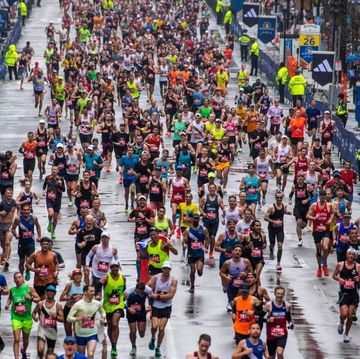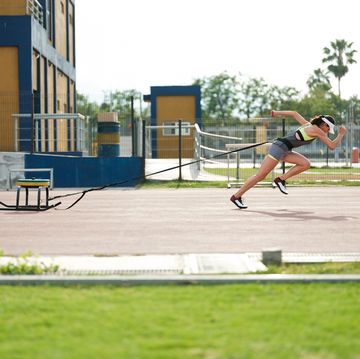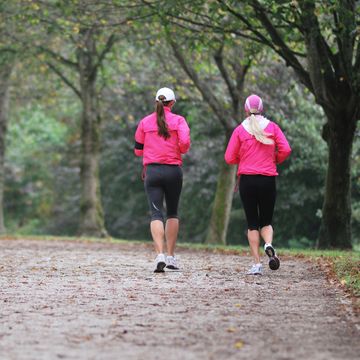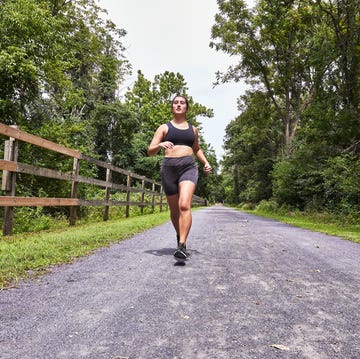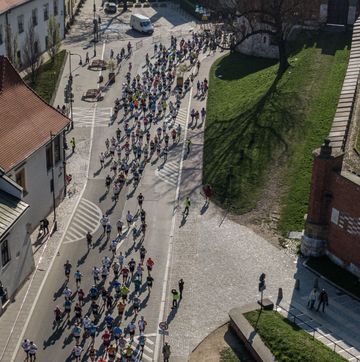It was a moment to behold: Alexa Efraimson, Elise Cranny and Sarah Baxter, three superstars of girls high school cross country—a mighty trio everyone had talked about since the summer—tearing away from the 2013 Nike Cross Nationals (NXN) field as soon as the cannon sounded on the Portland Meadows 5K racecourse in Portland, Ore.
Their start brought sizzle to the frigid December day. Each girl wore arm warmers in the 20-degree weather. Working together in the field of 199 championship runners, they merged into a unit like sled dogs—leading a vanguard of powerful young running talent.
It's happening in cross country and track, in the 800m up to the marathon: From the record-setter Mary Cain, 17, to this historic NXN trio and beyond, teenage girls are running much faster, with breakthroughs by the week.
Any data set provides evidence of this new era. In 2003, for both indoor and outdoor track, 12 girls broke 4:50 for 1600m and only one broke 4:45. Last year, in 2013, 35 girls broke 4:50 with 16 under 4:45. Likewise for the 3200m—in 2003, 12 girls broke 10:30. In 2013, 57 girls could claim the distinction.
“There's a new wave of stronger girls who keep getting better,” says Efraimson, a 16-year-old junior from Camas (Wash.) High School who was competing in her third NXN championship. “The opportunities have created a more confident generation of female runners.”
Efraimson's latest opportunity to test herself against older, seasoned women came in February at the Millrose Games at the New York Armory. She was invited to run the women's professional mile, headed by Cain. Despite the slow pace in the crowded 13-runner field, Efraimson placed sixth in 4:32.15 as Cain triumphed in 4:27.73. With her 62-second last quarter, Efraimson showed she could have run even faster with better conditions. “It was an awesome experience racing against the pros,” she said afterward, before signing autographs. “I was able to stay with it despite the bumping and pushing.”
Efraimson has experience against college women and international fields, which helped give her the poise to compete like a pro in New York. Last summer at the IAAF World Youth Games in Ukraine, Efraimson captured the 1500m bronze medal, close behind a pair of Ethiopians. Last October in Eugene, Ore., she defeated a field of top collegians in a 5K cross country race. In January in Seattle, against another open field, Efraimson ran an indoor 3,000m and set a U.S. high school record of 9:00.16.
Her record was on the same University of Washington track where Cain, the previous January as a high school junior already working with Alberto Salazar, also ran a record 3,000m, in 9:02.10. So Efraimson did Cain one better.
More breakthroughs are expected for these young stars later this year at events ranging from the Prefontaine Classic in Eugene to the IAAF World Junior Championships, coming to the United States for the first time (also in Eugene) July 22-27. Cain may enter the 1500m if the field looks fast enough. “The goal for her is to try and break 4 minutes this year,” Salazar says.
On the same day when Efraimson was showing her speed at Millrose, Cranny, a senior at Niwot (Colo.) High, was winning the U.S. national women's junior 6K cross country title by 51 seconds in Boulder, Colo. The elite high school races—and there are more of them every season—are not enough to quench the competitive thirst of these record-breaking teen girls.
What accounts for their success? How did so many girls get so good, so fast? The factors are many, from good nutrition and advanced training to a better understanding of girls' athletic potential.
MULTISPORT ATHLETES
As the rising sun on that Portland morning in December gave some comfort on the icy day, Efraimson and Cranny, along with Baxter, the two-time NXN defender from California, were in a race of their own. But the trailing pack was filled with girls who weren't exactly shrinking violets. One was Katie Rainsberger from Colorado, a 15-year-old sophomore who would finish sixth. A year-round runner and soccer player, Rainsberger has been groomed by her mother, Lisa Rainsberger, who was the last American woman to win Boston, in 1985. Lisa, who also coaches a youth running team, says that Katie's soccer and running complement one another and that she has brought her daughter along with an emphasis on good nutrition and muscle-building.
“It's the new ideal for girls,” says Lisa, who began her own career in swimming. To bolster her point, she refers to a contemporary of hers, Joan Benoit Samuelson, the 1984 Olympic marathon champion who grew up as a skier. “You don't have to be linear to be great. You don't have to focus only on running,” she says. “You have to become an athlete. The progress in running will come from that.”
There are many routes to athleticism. Efraimson, 5 feet 7% inches and 115 to 120 pounds, does elaborate sets of hurdle mobility drills, medicine ball work and calisthenics to build explosiveness. To the Rainsbergers, both mother and daughter, the new model is embodied by the likes of Cranny, Katie's broad-shouldered friend and state rival, who is also a two-sport athlete, competing in swimming as well as running. “Elise is the best thing that's happened to Katie,” Lisa says. Katie, who attends Air Academy in Colorado Springs, says that watching Cranny, Efraimson and Baxter take charge of NXN from her vantage point about 250 meters back was inspiring. “What they did was amazing,” she says. “I aspire to be like that.”
The New Jersey state cross country meet last November was a laboratory of girls who are multisport talents. The winner was a 15-year-old freshman, Briana Gess of Haddonfield, a muscular 5-foot-7 basketball player. The runner-up was senior Josette Norris of Tenafly, another basketball player, who went from a 5:10 1600m as a freshman to 4:41 as a junior and could challenge Cranny and Efraimson on the track this spring.
Whether it is basketball, swimming or soccer, maybe it's time for girls track and cross country coaches to recognize that other sports do not so much steal running talent as offer complementary fitness and a well-rounded athletic integrity.
At Fayetteville-Manlius, the innovative upstate New York school that won seven straight NXN girls championships, coach Bill Aris nurtures that integrity by regarding his male and female runners as athletic equals. “Our belief is, we're not boys or girls,” says Alana Pearl, a senior at F-M. “We're athletes.”
SKINNY IS OUT
In Lisa Rainsberger's view, a multisport layering from one year to the next is the best way to produce a complete runner. This approach, she says, has helped Katie, who runs only 38 miles a week because of soccer (and living at altitude). And, she says, her daughter has a “good relationship with food.”
That's a key trend in support of healthy, high-performance girls. Muscle is in, eating is cool. Smart eating, that is. Rainsberger, who has already grown to 5 feet 10 inches like her mother, has learned to regulate her own nutrition. But when she's unsure of something, she'll ask, “Mom, is this good to eat?”
Female runners are supported by the society at large. A new athletic aesthetic makes muscle development in girls culturally desirable, says Cheryl Cooky, associate professor in the Department of Health and Kinesiology at Purdue University and a specialist in women's sports and gender issues. This, she says, has caused a shift in how athletic girls are “experiencing their bodies.”
As Salazar puts it, “You want muscle on you. In the long term, being skinny is a negative.”
By skinny, Salazar means the old, extreme model that urged up-and-coming female runners to be as thin as possible. That viewpoint, at one time the cause of a culture of eating disorders, is increasingly passé.
Cooky says a growing body of research on what's known as the female athlete triad has emphasized how essential good nutrition is to a runner's health. “Scholarly attention put issues of amenorrhea, osteoporosis and eating disorders on the map,” says Cooky, a veteran of five marathons herself. “Female athletes have learned there are dire consequences in attempting to keep weight down.”
Kara Goucher, 35, the 2007 world championships bronze medalist in the 10,000m and third at the 2008 Boston Marathon, says that “girls are more athletic than they were when I was in high school 20 years ago.” Goucher, a two-time Foot Locker high school cross country finalist from Minnesota in the early '90s, appeared last December at NXN in Portland and Foot Locker nationals in San Diego. After observing both fields, Goucher says, “We're seeing a shift. Teenage girls are physically developed with muscular definition. I expect that the girls who are doing really well are going to have long careers.”
COACHES PUSHING HARDER
How do you handle a breakthrough performer like Alexa Efraimson? “We talk about ‘training age,’ “Mike Hickey, her coach, says. “I don't limit her because she's 16. I don't say Alexa can only do 'this much' or 'this workout.' If you do, you're saying that genetics don't matter and everyone is the same.”
Baxter, a senior at Simi Valley High who is going on to the University of Oregon, had come into the 2013 NXN event never having lost a high school cross country race. In an approach that was once considered daring but is now commonplace, Baxter trained with the Simi Valley boys for stepped-up workouts. Few boys could keep up with her. In winning her fourth straight California State Division II title last fall, Baxter, who clocked 16:43 for 5K, would have been the fourth scorer for the Pioneers' eighth-place boys squad that day.
“We now understand that girls can be pushed harder,” says Roger Evans, the longtime Simi Valley coach. “We have begun to see that girls are as strong and as durable as boys.”
That understanding shows in Baxter's workouts at Simi Valley. A sample hard cross country workout was 6 × 800m in 2:24 on a rolling trail with 6 × 170-yard hills in 38 seconds in the middle of the 800s. She'd end with a 2-mile tempo run back to school, hitting 5:00 for the last mile.
College coaches like Ray Treacy of Providence College, which won the 2013 NCAA women's cross country championship, have taken notice. Treacy, in his 30th year with the Friars, says there's more talent than ever in potential high school recruits. He attributes this development to health information available on the Internet to high school coaches, “who can do a better job of nurturing prodigies than in the past.”
The exchange of ideas has also led to training changes and smarter approaches to building strength, says Gina Procaccio, Villanova women's coach. “High school coaches know all about core work and cross-training,” says Procaccio, in her 20th year with the Wildcats. “When I ran at Villanova, no one knew what core work was.”
A NEW DAY
As the NXN race neared its conclusion and the crowd grew louder, it was clear to all that something special was taking place—that in the years to come, people would say they were at Portland Meadows on the day young women's racing changed. Through their surpassing power, Efraimson, Cranny and Baxter asserted something visionary. They're the first of many girls who are more complete athletes, shattering one myth after another in their ability to train hard and, as Cranny's coach, world-class marathoner Jason Hartmann, puts it, “race like an animal.”
The three leaders fought for position as the finish line neared. Efraimson, Cranny, Baxter. Who had the kick? The outcome notwithstanding, the race presented a showcase that stood to overshadow the team competition on which NXN was founded a decade before. “By excelling,” says Cranny, “each girl helps the other. We're feeding off one another.”
And let's remember: Cain, who is still in high school and is defining what a young female runner is capable of, was not even there. Had Cain not turned pro weeks earlier, the trio could have been a foursome—the American Dream Team for the Olympics. But Cain's aura was indeed in Portland. Her impact was felt.
“Mary Cain has had a big effect on us,” Efraimson says. “A lot of girls realize that maybe they can do the same things, too.” How ironic that Cain's last high school race before joining the open circuit in January 2013 was, in fact, NXN a month earlier. She lost that race by 25 meters to Baxter, who collected her second straight title.
Just in case Efraimson, in the swirl of the NXN competition, lost track of her durability, she had a written reminder on her leg that read, “It's going to hurt. You're going to want to die at the end. Give 100 percent and have no regrets.”
It was Efraimson whose kick prevailed; she won in a course-record 16:51. Cranny, Stanford-bound, took second in 16:54 with Baxter third in 16:58. The field was 33 seconds back. Rainsberger took sixth place in 17:38. In 2012, as a freshman, she'd placed 13th. “Hopefully,” she says, “in the next two years I can get to the level of Alexa.”
TREND SPOTTING The rise of girls' running performance is fueled by new patterns of training and coaching.
TREND NO. 1: Cain and Salazar
The impact of Alberto Salazar—the man who has developed the world's best distance runner, Mo Farah, and America's best distance runner, Galen Rupp—taking charge of the young Mary Cain of New York cannot be overstated. A 16-year-old girl joins a professional team on the other side of the country? It was a union fraught with great risk. But so far it has yielded spectacular results.
Many high school girls are on the record as saying they look up to Cain, not only for her string of records but for her poise, charm and humility. She's the compete package, the face of American track and field right now. Salazar is breaking new ground with Cain, who is now 17 and planning to continue her professional running with the Nike Oregon Project while attending the University of Portland after she graduates from Bronxville (N.Y) High School this spring.
Salazar has been up-front about Cain's development, helping girls and their coaches glean training specifics as well as overall philosophy. While there is recognition of Cain as a once-in-a-generation prodigy, there is also the feeling that her attributes are accessible.
Salazar admits that in his first year of coaching Cain, after starting in the fall of 2012, there was “a lot of guesswork.” Last year, her volume reached 60 to 65 miles a week. He used trial and error for speed work. He concentrated on refining Cain's form.
Salazar believes that a top high school girl should be trained in the same way as a top high school boy. As he puts it, “I would push them just as hard. A girl running a 4:35 mile should do the same workouts as a boy running 4:35.”
High school coaches are starting to adopt the Salazar novelty of doing workouts immediately after racing—which Cain says she loves. Cain has continued her record-breaking streak in 2014: She set a world junior indoor 1,000m mark (2:39.25) in Boston in January. Then she did the following workout: 4 × 800m in 2:24 average and 4 × 400m in 59.2 average.
TREND NO. 2: Independents' Day
Enlightened girls learn from enlightened coaches. Even with the high school coaching fraternity at a peak in expertise and commitment, enterprising girls and their families are seeking greater authority beyond the school programs, as Cain did with Salazar. When Mike Hickey, who coached Alexa Efraimson at Camas (Wash.) High School during her freshman and sophomore years, left the school to coach a college program, Efraimson, who turned 17 in February, continued working with him. Jason Hartmann, a 2:11 marathoner who finished fourth at the Boston Marathon in 2012 and 2013, was an assistant coach at Niwot (Colo.) High School, where he first worked with Elise Cranny. Even though he no longer coaches at Niwot, Hartmann still guides her training.
Cain made big news last fall when she turned pro and signed with Nike. It's obvious that high school and college running would have held her back.
This vein of independence in young women seeking advanced handling outside traditional realms has historical precedent. In the pre-Title IX amateur era, before official girls high school track or cross country even existed, the likes of Mary Decker Slaney, Francie Larrieu Smith, Joan Benoit Samuelson and Lynn Jennings had no choice as teenagers but to train with men, join AAU clubs and enlist private coaches. Does the fact that all four women achieved long-term worldwide success speak to their independent upbringing, or would conventional high school (and college) channels have resulted in the same stardom?
Alana Hadley, a 17-year-old junior at Ardrey Kell High School in Charlotte, N.C., is not waiting to find out. She has decided not to run for her high school or, later on, a college team. Instead, Hadley has struck out on her own as a young marathoner, doing 100-plus miles a week with her father, Mark, as coach. Last October, Hadley ran 2:41:55 to finish fourth at the Monumental Marathon in Indianapolis, qualifying for the 2016 Olympic marathon trials. She has accepted prize money and is the youngest trials qualifier (16 at the time) since Cathy Schiro of New Hampshire in 1984.
In defending his daughter's decision and high mileage against criticism in social media, Mark Hadley released a statement last fall saying that Alana preferred long distances, raced infrequently, never had a major injury and “has grown and gone through puberty without delay.”
A possible future rival of Hadley's in the 10K and beyond, Cayla Hatton of Connecticut, another young phenom, last fall quit the Stanford team as her sophomore year began. In high school, Hatton had attended Phillips Academy in Andover, Mass. She competed on her own with a private coach, producing spectacular times like a 33:17.28 for 10,000m, the fastest ever by a U.S. 17-year-old girl, and a 15:50.32 for fourth in the 2012 world junior 5,000m in Barcelona, the best finish ever by an American.
One of Hatton's Barcelona teammates, world junior 800m champion Ajee' Wilson of New Jersey, has also chosen to sidestep the college system. Closely watched after running 2:00.59 in the 800m on a relay as a Neptune High sophomore in 2010, Wilson, after her 2012 graduation, accepted a scholarship to Florida State. However, instead of going to Tallahassee, she decided to forgo the scholarship, attend Temple University, work with a private coach in Philadelphia and turn pro with a contract from adidas. Last summer, at 19, she placed sixth in the world championships 800m in Moscow. Her time of 1:58.21 put Wilson 0.3 seconds from the bronze medal.
TREND NO. 3: Parents Who Have Been There
The familiar horror stories of parents pushing their child runners to injury and burnout have given way to an attitude in which athletic moms and dads are saying, “Running is great; look at us, but do what you think is best.” it's a keeper.
For examples of the new family form, it's hard to beat the Efraimsons of Washington and Crannys of Colorado and their elite daughters, Alexa and Elise, respectively. Alexa's parents are swimmers, and her mother, Chantel, is an Ironman triathlete. Elise's parents are multisport athletes, and her father, Bob, has done Ironman events. Alexa and Elise absorbed good ideas and ran with them.
So what are the chances that Chantel Efraimson and Bob Cranny could end up competing against one another in the same triathlon? It actually happened last September at the Lake Tahoe Ironman—a 2.4-mile swim, 112-mile bike ride and a marathon. After more than 12 hours of racing, Efraimson placed 390th and Cranny 398th in the field of 2,748 finishers.
For a teenage girl, there is no better influence than an active parent. Seeing her mother go the limit has helped Alexa fulfill her dreams. “She inspires me when she's able to do these crazy five-hour bike rides,” Alexa says. “I think to myself, 'Oh, goodness, that's a long ride.' “
TREND NO. 4: Big Meets, Big Sponsors
The national landscape of championship and elite invitational events (and plenty of free trips) keeps growing with barely a letup through the cross country, indoor and outdoor track seasons. Nike, New Balance and Foot Locker are the biggest benefactors, with adidas, Brooks, Saucony and ASICS also involved in what is perceived as a hot youth market. International events like the IAAF World Junior Championships and World Youth Games have become major draws.
The Young Elite Female Runner
PAST AND PRESENT
THE LINEUP // Teen Stars
(ages as of March 1)
MARY CAIN, 17
Bronxville (N.Y.) High School
Superstar who turned pro in her senior year, made last summer's world championships 1500m final in Moscow and finished 10th. She ran 4:04.62 for 1500m last spring.
SARAH BAXTER, 17
Simi Valley (Calif.) High School
Oregon-bound high school senior who was undefeated in four years of California cross country. She won NXN championships in 2011 and 2012 (over Cain) and placed third in 2013.
Neptune (N.J.) High School
High school graduate in 2012 who turned pro at 18 and placed sixth at 19 in last summer's world championships 800m. She ran 1:58.21, within a stride of the bronze medal.
ALANA HADLEY, 17
Ardrey Kell (N.C.) High School
A junior, coached by her dad, who trains 100 miles a week. Last fall, at 16, she ran a 2:41:55 marathon to become the youngest women's qualifier for the Olympic trials since Cathy Schiro in 1984.
, 17
Camas (Wash.) High School
High school junior who won the 2013 Nike Cross Nationals (NXN), captured the IAAF World Youth Games 1500m bronze medal last summer in Ukraine and ran a world-level 9:00.16 indoor 3,000m in January.
, 18
Abington Heights (Pa.) High School
High School senior bound for Penn State who won the 2013 Foot Locker cross country title and captured the 2-mile and 5,000m at 2014 indoor nationals, the latter by 25 seconds in a national-record 16:11.85.
, 17
Niwot (Colo.) High School
A Stanford-bound high school senior coached by world-class marathoner Jason Hartmann who took second to Efraimson at NXN and has a 1500m PR of 4:15.07. She won the 2014 USA junior cross country title by 51 seconds.
, 15
Air Academy (Colo.) High School
A sophomore who ran Cranny to the wire as a freshman in the state cross country meet and placed sixth at NXN last December Her mother, Lisa, is a former world-class marathoner.
RUNNING THE NUMBERS
| 20-Year Performance Trends | ||
| Year | Sub-4:50 1600M | Sub-10:30 3200M |
| 1993 | 1 | 3 |
| 2003 | 12 | 12 |
| 2013 | 35 | 57 |
| Participation in Girls Cross Country and Track Nationwide | |||
| Year | Cross Country | Indoor Track | Outdoor Track |
| 2007-2008 | 190,344 | 59,532 | 447,520 |
| 2012-2013 | 214,369 | 63,298 | 472,939 |
Source for 20-Year Performance Trends: Jack Shepard's High School Track annuals; girls listings compiled by Doug Speck and Mike Kennedy
Source for Participation in Girls Cross Country and Track Nationwide : National Federation of State High School Associations

Marc Bloom’s high school cross-country rankings have played an influential role in the sport for more than 20 years and led to the creation of many major events, including Nike Cross Nationals and the Great American Cross Country Festival. He published his cross-country journal, Harrier, for more than two decades.




